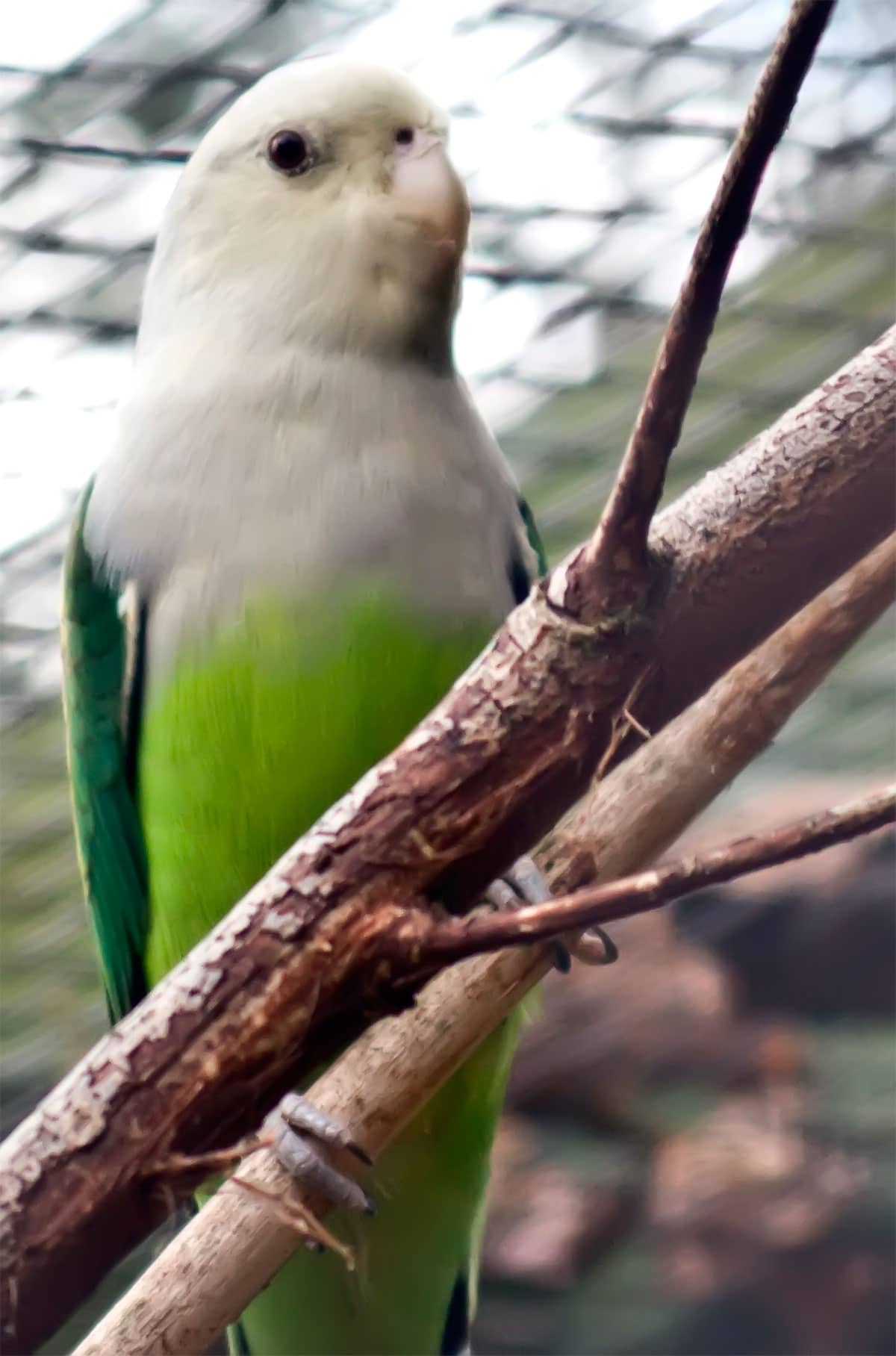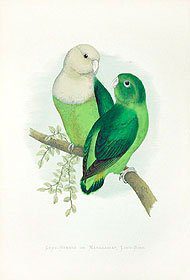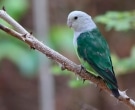Content |
|---|
Description:
From between 13 and 15 cm in length and a weight between 25 and 31 g..
The Gray-headed Lovebird (Agapornis canus) has the head and the neck pale grey. Mantle and green scapulars; rump with a much brighter green than the rest of the tops. Upper, the wing-coverts green, alula dark. Flight feathers green above, darker towards tip and margins to the vane outer; grayish brown below. Under, the wing-coverts black. The throat to the top of the chest pale grey; low area chest up to the undertail- coverts pale yellowish green. Upper, the tail green, by bright side, with broad subterminal black band; undertail, the tail greenish-grey.
The upper jaw bluish white, the lower white pink; irises dark brown; legs pale grey.
The female has the head, neck and chest green; upperparts sometimes more brown than the male. Under, the wing-coverts green.
The immature adults resemble, but the gray hood the male is steeped in green, especially in the nape; bill yellow with black on the basis of upper jaw.
- Sound of the Gray-headed Lovebird.
Subspecies description:
It notes that within the species Grey-headed Lovebird, given the presence of 2 subspecies, which are Agapornis canus canus (Gmelin); Agapornis canus ablectaneus (Bangs); However, not known no kind of mutation, What is something special in this genre, as usually, each species has different mutations, you change the color of its plumage.
- Agapornis canus ablectaneus (Bangs, 1918) – Greener (less yellowish) below, head violet gray con held tinkles.
- Agapornis canus canus (Gmelin, 1788) – The nominal species
Habitat:
In Madagascar They are in some wooded areas, palm savannas, forest edges, degraded forests, bush and farmland and rice paddies to altitudes 1.500 m. Use the clear in the dense forest along the mountainsides.
Observed in the vicinity of cities and towns and, often seen on the roads. Introduced populations show similar habitat preferences.
gregarious, usually in flocks of up to 50 birds, being able to concentrate in greater numbers in areas where food is abundant, sometimes it partnering with Madagascar Red Fody (Foudia madagascariensis), the Sakalava Weaver (Ploceus sakalava) or the Madagascar Munia (Lepidopygia nana). They often gather at communal roosts in the bare branches.
Sedentary.
Reproduction:
The nests of the Gray-headed Lovebird are treeholes; Inside the hole is lined with fragments of chewed leaves or wood chips and stalks of grass worn by females between body feathers.
Nesting They were recorded in the months of November and December in Madagascar. Probably they breed during the rainy season (November–April) in Comoros.
The laying is of 4-5 eggs, but up to eight they have been recorded in captivity.
The incubation, probably, the female performs single, lasts a few 23 days and the young leave the nest after about forty days.
Food:
The diet Gray-headed Lovebird consists, mainly, of grass seeds.
In Seychelles They have a preference for the crop pasto guinea (Megathyrsus maximus); in the Comoros islands by flower buds Stenotaphrum. They also eat rice out to dry around the villages and farms.
Distribution:
Madagascar It is the natural range of the Gray-headed Lovebird, where usually are common, especially in coastal regions, but today they are rare in eastern and absent or scarce in the central plateau.
Introduced Comoros, Seychelles, Rodrigues, Meeting, Mauritius, Zanzibar and Mafia; apparently missing on the last three islands and only a small number on Rodrigues and Meeting, but widespread and generally common in Comoros.
In Seychelles, initially established extensively in Mahe but now confined to the suburbs around Victoria and some towns of the West Coast; small town, according to sources, in Silhouette.
Attempts to introduce them to other islands and in Africa have failed.
Subspecies distribution:
- Agapornis canus ablectaneus (Bangs, 1918) – Arid lowlands of southwestern Madagascar, intergrades the species nominal about Beth kopaka and Ankavandra
- Agapornis canus canus (Gmelin, 1788) – The nominal species
Conservation:
• Current Red List of UICN: Least concern
• Population trend: Stable
The size of the world population Gray-headed Lovebird It has not been quantified, but the species, according to sources, It common and it is generally Extended. (pit et to the. 1997).
The population is suspected to be stable in the absence of evidence of any reduction or substantial threats.
The species has undergone intense trade: from 1981 when it was listed in Appendix II of CITES, 107,829 wild-caught individuals They were recorded in international trade (UNEP-WCMC CITES Trade Database, January 2005).
After a total ban on exports from Madagascar, in recent years it has been possible to have some imported specimens.
,
"Gray-headed Lovebird" in captivity:
The Gray-headed Lovebird they are very rarely seen in captivity, Since this species it is not widespread today.
The Gray-headed Lovebird It is a pretty bird silent; active; often shy and elusive; Just get used to his caregiver patiently and in a gradual manner; newly imported birds, initially they are very susceptible; reared in aviaries not usually give complications; It hard chewer; enjoy bath; his voice is not too loud; communal aviary is not recommended because its something rowdiness; He tolerates only birds of the same species in large aviaries where you can implement your flight.
With regard to its longevity, they can live between 10 and 20 years.
Alternative names:
– Gray-headed Lovebird, Gray headed Lovebird, Grey headed Lovebird, Grey-headed Lovebird, Madagascar Lovebird (English).
– Inséparable à tête grise, Inséparable cana (French).
– Grauköpfchen, Grauköpchen (German).
– Inseparável-de-faces-cinzentas (Portuguese).
– Inseparable de Cabeza Gris, Inseparable Malgache, Agapornis Cana, Inseparable de Madagascar (español).
scientific classification:

– Order: Psittaciformes
– Family: Psittaculidae
– Genus: Lovebirds
– Scientific name: Agapornis canus
– Citation: (Gmelin, JF, 1788)
– Protonimo: Psittacus canus
Images “Gray-headed Lovebird”:
Videos "Gray-headed Lovebird"
Gray-headed Lovebird (Agapornis canus)
Sources:
Avibase
Parrots of the World – Forshaw Joseph M
Parrots A Guide to the Parrots of the World – Tony Juniper & Mike Parr
Birdlife
Photos:
(1) – A male Grey-headed Lovebird at Beale Park, Berkshire, England By Tony Austin (originally posted to Flickr as Parrot) [CC BY 2.0], via Wikimedia Commons
(2) – Grey-headed Lovebird, Ankarafantsika, Madagascar By Frank Vassen [CC BY 2.0], via Wikimedia Commons
(3) – Grey-headed Lovebird or Madagascar Lovebird By OPi@Toumoto(Opi @ Tomoto) -> http://opi.toumoto.net (Self-photographed) [GFDL or CC-BY-SA-3.0], via Wikimedia Commons
(4) – the whole family… by ZaR – ipernity
(5) – we Pedia
Sounds: Mike Nelson (Xeno-canto)








I WANT TO START BREEDING AGAPORNIS CANA, BUT I'M IN TROUBLE FINDS HIM. I LIVE IN IBIRAÇU-ES.